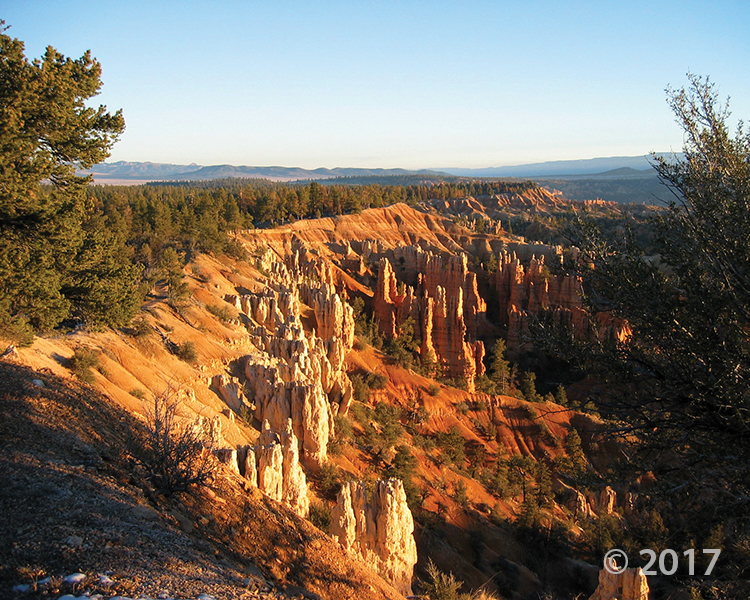Caineville Badlands, Wayne County
Photographer: Gregg Beukelman © 2017
The view from North Caineville Mesa reveals convoluted patterns eroded into the Blue Gate Member of the Cretaceous-age Mancos Shale. The reddish deposits are remnants of a landslide sourced from the Emery Sandstone Member of the Mancos Shale.
Bryce Canyon National Park
Photographer: Grant Willis © 2017
Bryce Canyon National Park is actually a plateau-edge escarpment carved into the Claron Formation, estimated to be eroding back at the phenomenal rate of as much as 4 feet per century. The orange colors are due to varying amounts of iron oxide minerals that stain calcareous (limey) ancient soil, lake, marsh, and floodplain deposits of the Claron Formation.
Little Cottonwood Canyon, Wasatch Range
Photographer: Michael Vanden Berg © 2017
Alpine wildflowers color the slopes of Albion Basin at the head of Little Cottonwood Canyon. The 11,000-foot-high peaks of the central Wasatch Range owe their height to vertical movement on the Wasatch fault over the past 15 million years.
Tower of Babel, Arches National Park, Grand County
Photographer: Kent Brown © 2017

Modern dunes, Arches National Park
Photographer: Kent Brown © 2017

Modern dunes (foreground) consist of sand weathered from bedrock such as the Wingate Sandstone (skyline), which similarly formed from sand deposited in dunes 200 million years ago.
Little Cottonwood Canyon, Salt Lake County
Photographer: Adam McKean © 2017

Interbedded shale and quartzite of the Precambrian Big Cottonwood Formation are dramatically folded and faulted on the sheer face of Twin Peaks in Little Cottonwood Canyon. The intrusive Tertiary-age Little Cottonwood granite stock forms the light-gray, glaciated peaks in the distance.
Devils Garden Natural Area, Grand Staircase-Escalante National Monument
Photographer: Bill Lund © 2017

Metate Arch, formed in the Entrada Sandstone, is a classic example of a caprock natural arch.
Big Cottonwood Canyon, Wasatch Range
Photographer: Mike Hylland © 2017

The waters of Lake Blanche reflect Sundial Peak, composed of quartzite of the Big Cottonwood Formation. Rocks in this basin, which formed from sediment that accumulated along a continental margin 900 million years ago, preserve striations (parallel scratches and grooves) that record the down-valley flow of Ice Age glaciers.






